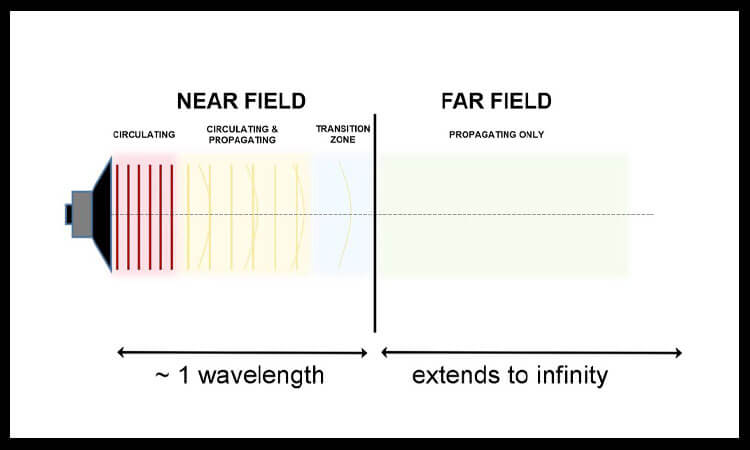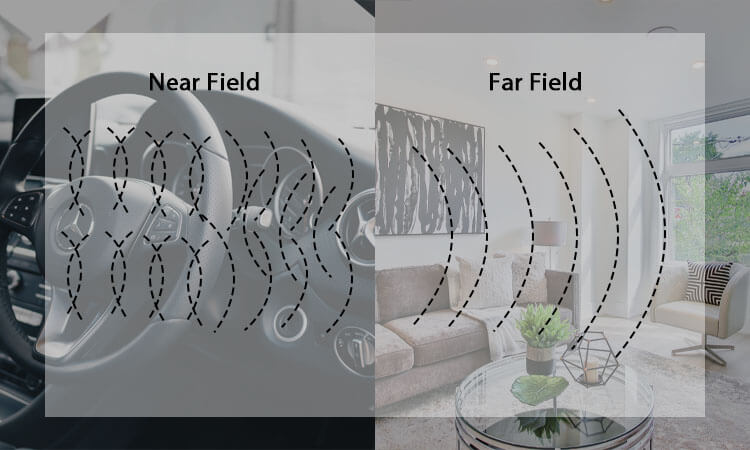What do you know about the electromagnetic field? Do you know the difference between the near field and the far field of your car and house? Well, I’m here to tell you. The near field is the area around an object that can produce a magnetic field, while the far field is where the magnetic field is much weaker. In this article, we’ll explore both fields and how they affect us when driving or sitting on our couch at home!
What is an Electromagnetic Field?
An electromagnetic field is a region of space that the presence of electric or magnetic energy has modified. The presence of these types of energy results in the generation of waves and other forms of energy that can move through space
In other words, an electromagnetic field is made up of electric and magnetic fields. Any object with a static electric charge or magnetic pole will create its unique electromagnetic field.
Near Field vs Far Field

Near field and far field are terms that describe areas around a transmitting source. The near field is the first few meters of space around a transmitting source, while the far field is everything that’s beyond that. The difference between these two areas can be seen in an experiment described by Jearl Walker in his book “Fundamentals of Applied Electromagnetics.” In this experiment, a transmitter sends signals at various power levels and distances (within the near and far fields) to show how much power is lost over distance—which means it also shows how concentrated energy can be.
While the near field is much stronger than the far field, its energy is much more dispersed than what you’d get from a cell phone tower or broadcast TV signal. You could say that your car has almost as much radiation as your house does—but your car’s emissions are so small compared to those of houses and cell towers that they don’t matter for most people who aren’t driving in a lead-lined suit 24/7.
In fact, the amount of radiation you’re exposed to in your car is equivalent to the amount of solar radiation you’d get from sitting outside in the summer sun for several hours. This is because cars are made of metal and plastic—which means they reflect most electromagnetic waves rather than absorbing them (like most organic materials).
Near-Field Regions
The near-field region was a region of radiation between the antenna and the free space. The range of interest for wireless communications in frequency ranges that use radio waves is only a few meters. The farther away from the transmitter, the less power radiates into it.
In a near-field region, the electric field strength is emitted in all directions, which means that electromagnetic waves can be reflected and scattered by nearby materials. In the case of an antenna, this can lead to crosstalk problems because it affects adjacent channels on the same frequency band.
The Reactive Near-Field Region
According to recent research, the reactivity of the near-field region is significantly greater than the far-field region. This means that the magnetic field is more reactive in the near-field region than in the far-field region. However, this difference between the two regions can be easily canceled out using non-radioactive materials as dielectric media. No significant amplitude loss will occur if a loop antenna receives electromagnetic waves using its non-radioactive material as the dielectric medium between two loops continuously.
Far-Field Regions
The far-field region is the same distance from the antenna as the other regions and follows a similar pattern. In fact, what makes it different from other larger regions is that energy losses in this region are fairly low. This can be attributed to the lower amount of scattering in this region compared to other regions — which contributes to how much space is needed for antennas to make up for the effect of multipath propagation. Electromagnetic waves scattered by objects within this region play a crucial role in transmitting information between two points when an electromagnetic wave first enters one building before exiting another building miles away after reflecting off of buildings or objects along its path.
Why does It Matter?
Electromagnetic fields are electromagnetic waves that exist around the globe and are a type of energy. Electromagnetic fields can be dangerous to your health, so it’s important to know how they affect you and what you can do to protect yourself.
An electromagnetic field comprises a combination of electric and magnetic fields that form an electromagnetic spectrum; this spectrum includes radio waves, microwaves, infrared radiation (heat), visible light, ultraviolet radiation (sunburns), X-rays, gamma rays, cosmic rays, and more. All these different types of electromagnetic radiation have different energy levels—some are harmless, while others can cause cancer or congenital disabilities. For example, Microwaves used in ovens emit much lower levels than those found on cell phones; both types may lead to headaches, but only one has potential long-term effects for developing cancer later in life.
The dangers of electromagnetic fields are still being studied, but a growing body of evidence suggests they can cause health problems. The World Health Organization (WHO) has classified EMFs as “possibly carcinogenic to humans” based on research showing an increased risk of brain tumors and acoustic neuromas in people who have used cell phones for over 10 years.
The WHO also noted that children might be more susceptible to EMFs than adults, which is why they recommend limiting cell phone use by children under 18.
How Does That Relate to Your Car and Your House?
The electromagnetic field around your car is different and much stronger than your house. Why? Because it’s not just any old electromagnetic field—it’s a high-frequency one.
A high-frequency (HF) signal can carry more information at a time than low frequencies, which means it can transmit information over long distances with less power than lower-frequency signals require. This makes HF technology ideal for telecommunications and radar systems. In fact, we’re already using HF technology to communicate with satellites!
The radio waves that our cell phones use are also HF technology. It’s the same technology that allows us to communicate with each other, but it’s not just our phones—anything that uses radio waves as its main form of communication.
So, what does this mean for you and your car? Well, it means your car has its own radio station inside it! The high-frequency electromagnetic field that’s generated by your alternator is strong enough to communicate with other cars on the road—and even with towers miles away! But how do we know this?
The answer is simple: We know this because we can see it in action! In fact, a video on YouTube shows a car’s alternator sending out radio waves from the back of the vehicle.
How do We Change the Electromagnetic Field?
The electrical and magnetic fields can be changed in four ways: frequency, direction, intensity, and duration. Changing the frequency means changing the number of times a wave oscillates per second. If you change from 60 Hz to 50 Hz electricity, you might notice that your lights appear dimmer or flicker more often. This is because your new frequency will cause resonance with other frequencies in certain objects (like light bulbs), which causes them to vibrate—and thus burn out faster than normal!
Changing the direction of an electromagnetic field changes the orientation of electric and magnetic fields relative to one another at any given point in space. This is different from changing intensity and duration because it relates specifically to how they interact with matter to produce heat or light (or something else).
Changing the intensity of an electromagnetic field is essentially the same as changing its frequency: it changes how many times per second a wave oscillates. If you change from 60 Hz to 50 Hz electricity, you might notice that your lights appear dimmer or flicker more often. This is because your new frequency will cause resonance with other frequencies in certain objects (like light bulbs) which causes them to vibrate—and thus burn out faster than normal!
What is the Difference between the Electromagnetic Field in Your Car and the One in Your House?
There is a clear difference between your car’s electromagnetic field and your home’s electromagnetic field. The near-field is used in cars, while the far-field devices are used in homes.
Far-field devices are dangerous because they can cause cancer and other health problems. These fields can affect people long distances and have been linked to various cancers, including leukemia and brain tumors. You may have heard about some public schools being sued due to their use of WiFi routers or cell towers being too close to where students spend most of their time at school (like classrooms). This kind of exposure also makes it harder for children to learn because they’re distracted by feeling sick from radiation exposure.
Near-field devices are harmless compared to far-field ones. Still, they can interfere with your phone if you’re trying to make calls or send text messages while driving down the road with them turned on inside your vehicle (because there aren’t any walls separating you from other drivers)!
Near Field vs Far Field in Everyday Life
Before we talk about what “near field” and “far field” mean, let’s look at some examples of electromagnetic fields around us. You may already be familiar with the concept of “far-field” since it is commonly used in everyday life: for example, when you turn on your car or start running in a gym. These are examples of electromagnetic fields that occur at a distance from your body, making them far from you and nearby. It’s also common to see this type of power supply used in homes and buildings because it’s cheaper than installing an electrical outlet near where you want to use electricity (like near your bed).
Near-field radiation can also be found where there are sources like cell phone towers or WiFi routers–these emit radio frequency (RF) energy directly into our environment and create waves that carry information between devices. The higher the RF output strength, the greater the chance there will be some health impact associated with using these technologies over long periods; however, there is still debate on whether these effects exist!
Much research is being done on this topic today, but there are still many unknowns. We know that it’s important to be aware of the potential health risks associated with electromagnetic radiation so that you can make informed decisions about how to protect yourself and your loved ones from harm.
Conclusion
There are many differences between your car and your house. One of the most significant is how much power they can handle from a radio transmitter. In short, far-field radio waves are affected by objects close to them, while near-field waves don’t care about anything except their surroundings when they’re being emitted. This means that if you drive around with an FM radio station in your car’s stereo system, it won’t matter what other cars are doing or where they’re positioned because their distance doesn’t affect reception quality!









